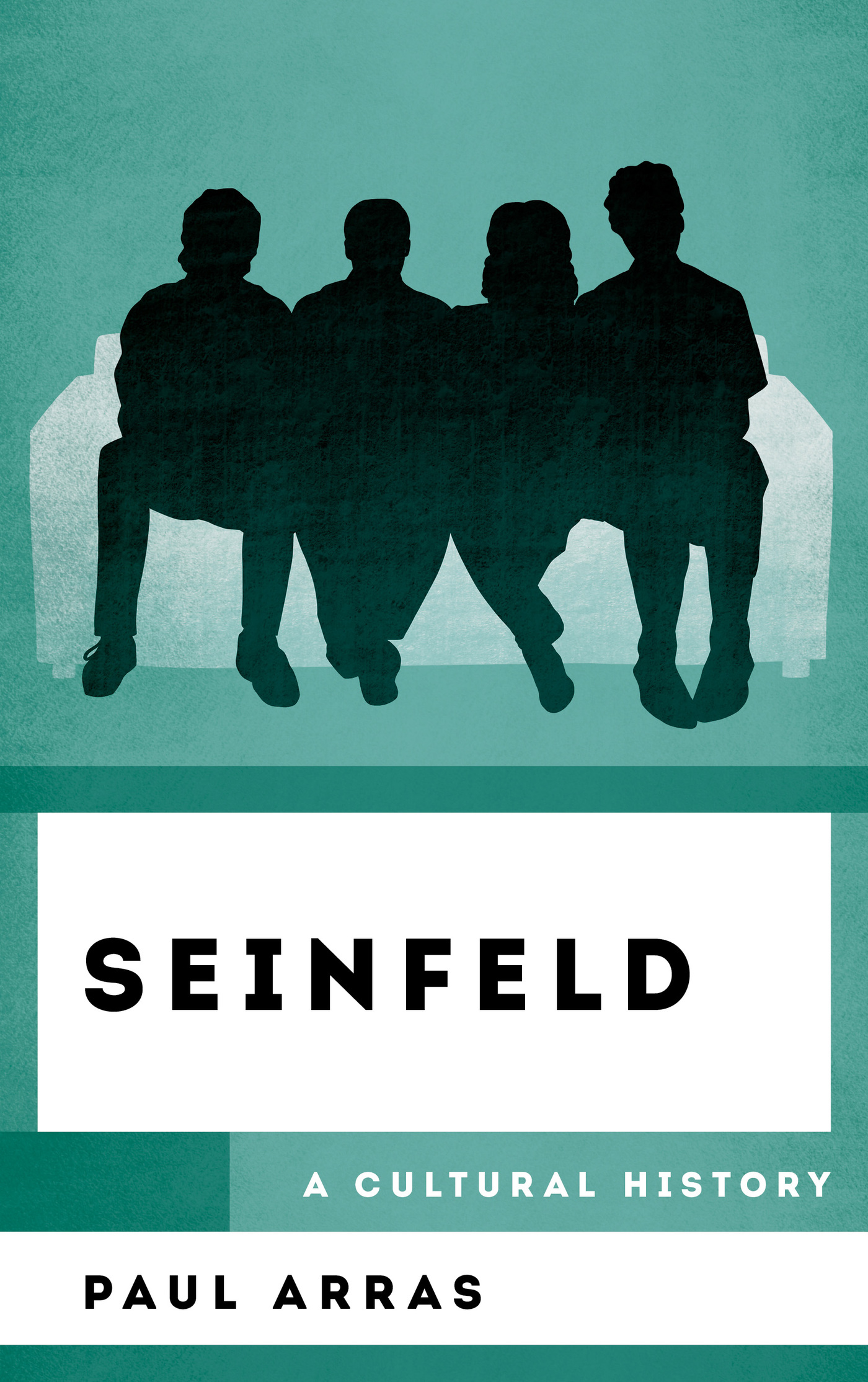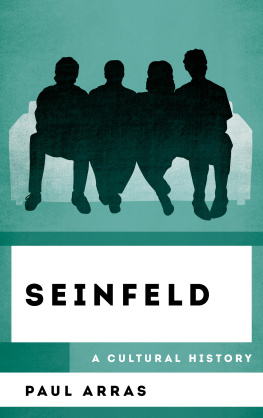Paul Arras - Seinfeld: A Cultural History
Here you can read online Paul Arras - Seinfeld: A Cultural History full text of the book (entire story) in english for free. Download pdf and epub, get meaning, cover and reviews about this ebook. year: 2012, publisher: Rowman & Littlefield Publishers, genre: Non-fiction. Description of the work, (preface) as well as reviews are available. Best literature library LitArk.com created for fans of good reading and offers a wide selection of genres:
Romance novel
Science fiction
Adventure
Detective
Science
History
Home and family
Prose
Art
Politics
Computer
Non-fiction
Religion
Business
Children
Humor
Choose a favorite category and find really read worthwhile books. Enjoy immersion in the world of imagination, feel the emotions of the characters or learn something new for yourself, make an fascinating discovery.
- Book:Seinfeld: A Cultural History
- Author:
- Publisher:Rowman & Littlefield Publishers
- Genre:
- Year:2012
- Rating:5 / 5
- Favourites:Add to favourites
- Your mark:
- 100
- 1
- 2
- 3
- 4
- 5
Seinfeld: A Cultural History: summary, description and annotation
We offer to read an annotation, description, summary or preface (depends on what the author of the book "Seinfeld: A Cultural History" wrote himself). If you haven't found the necessary information about the book — write in the comments, we will try to find it.
Seinfeld: A Cultural History — read online for free the complete book (whole text) full work
Below is the text of the book, divided by pages. System saving the place of the last page read, allows you to conveniently read the book "Seinfeld: A Cultural History" online for free, without having to search again every time where you left off. Put a bookmark, and you can go to the page where you finished reading at any time.
Font size:
Interval:
Bookmark:
Seinfeld
The Cultural History of Television
Series Editors: Bob Batchelor, M. Keith Booker, and Kathleen M. Turner
Mad Men: A Cultural History, by M. Keith Booker and Bob Batchelor
Frasier: A Cultural History, by Joseph J. Darowski and Kate Darowski
Breaking Bad: A Cultural History, by Lara Stache
Star Trek: A Cultural History, by M. Keith Booker
The Simpsons: A Cultural History, by Moritz Fink
Cheers: A Cultural History, by Joseph J. Darowski and Kate Darowski
Gilmore Girls: A Cultural History, by Lara Stache and Rachel Davidson
Friends: A Cultural History, by Jennifer C. Dunn
Seinfeld: A Cultural History, by Paul Arras
Seinfeld
A Cultural History
Paul Arras
ROWMAN & LITTLEFIELD
Lanham Boulder New York London
Published by Rowman & Littlefield
An imprint of The Rowman & Littlefield Publishing Group, Inc.
4501 Forbes Boulevard, Suite 200, Lanham, Maryland 20706
www.rowman.com
6 Tinworth Street, London SE11 5AL
Copyright 2020 by The Rowman & Littlefield Publishing Group, Inc.
All rights reserved. No part of this book may be reproduced in any form or by any electronic or mechanical means, including information storage and retrieval systems, without written permission from the publisher, except by a reviewer who may quote passages in a review.
British Library Cataloguing in Publication Information Available
Library of Congress Cataloging-in-Publication Data
Names: Arras, Paul, 1981 author.
Title: Seinfeld : a cultural history / Paul Arras.
Description: Lanham : Rowman & Littlefield, [2020] | Series: The cultural history of television | Includes bibliographical references and index. | Summary: This book traces the history of Seinfelds path onto NBCs schedule and rise up the Nielsen ratings, offering a fresh look at the episodes themselves. It pays close attention to the writers and writing of the show, carefully analyzing individual episodes to articulate exactly what was so groundbreaking and assessing its broader cultural impact.Provided by publisher.
Identifiers: LCCN 2019056194 (print) | LCCN 2019056195 (ebook) | ISBN 9781538126875 (cloth) | ISBN 9781538126882 (epub)
Subjects: LCSH: Seinfeld (Television program)
Classification: LCC PN1992.77.S4285 A88 2020 (print) | LCC PN1992.77.S4285 (ebook) | DDC 791.45/72dc23
LC record available at https://lccn.loc.gov/2019056194
LC ebook record available at https://lccn.loc.gov/2019056195
 TM The paper used in this publication meets the minimum requirements of American National Standard for Information Sciences Permanence of Paper for Printed Library Materials, ANSI/NISO Z39.48-1992.
TM The paper used in this publication meets the minimum requirements of American National Standard for Information Sciences Permanence of Paper for Printed Library Materials, ANSI/NISO Z39.48-1992.
For Mom and Dad

This book doesnt turn into a coffee table. It doesnt have any built-in legs to prop it up. However, there have been many people who have helped prop up the project. Foremost, Taylor Arras read the manuscript, rewatched Seinfeld with me, and supported me in so many ways. Our boys, Henry (age four) and Matthew (two), also supported me in their own ways, even though they wont be allowed to watch Seinfeld for another decade.
I first watched Seinfeld with my familymy brother, Dan, who shares my sense of humor, and my parents, Jane and Al, to whom this book is dedicated. Im grateful that Mom and Dad raised me to be kinder than Jerry, happier than George, and more content than Elaine. They also endowed me with the independence and courage to be a little like Kramer.
At its best, television brings people together for a shared experience of both pleasure and meaning. Over the years, I have shared the experience of Seinfeld with so many friends who helped me ponder its meanings. Those friends include: John, James, Chris, Short Paul, Pandeezy, Other Paul, Maarten, Nasdaf, Brendan, General Taft, Em, Jo, Galdo, Brady, Peter (my patron) and his team (including the J.A.M. session), Cousin Mark, Cousin Eric, Cousin Brian, Professor ELQ and the Writing Workshop, Dr. Bob, Steve and Janet, the Crazy Club, Patches and Redfield, SHA, Nathan and Friends Boat Dock Installers and Removers, Bob Sacamano, everyone who has ever been on the Real Paul Arras Tour, and many others. Thanks also to everyone who worked on this book at Rowman & Littlefielda much better publishing house than Pendant Publishing.
Thanks to you, too, reader! I hope that this book helps you appreciate Seinfeld in new ways. Come find me on the internet if you want to argue about my episode rankings, but only if youre as nice as Bizarro Jerry and his friends.
Seinfelds success came out of nothing. The show barely made it onto NBCs schedule and barely survived its first few seasons. For several years, Seinfeld struggled to gain traction, with only about 1520 million people tuning in each week during its brief first season.
Only 20 million? A few decades later, a sitcom would kill to get an audience of that size, but in 1990, television viewers were still grouped around a few channels. Cable networks claimed a small (but growing) fraction of the audience, while the broadcast networksNBC, CBS, ABC, and even Fox (launched in 1986)battled over most of the viewers. Seinfeld was the last great sitcom of this broadcast age. After Seinfeld, the television audience splintered, chasing content onto different channels and different platforms.
By the time its much-hyped finale aired, it seemed everyone was talking about Seinfeld. That feeling of a national audience now seems impossible to duplicate. Shows like Game of Thrones, The Bachelor, and The Big Bang Theory can rise to the top of American culture for a period. But those fleeting moments are nothing like Seinfelds cultural supremacy in the 1990s. In its final season, NBC was paying record-high salaries to the cast and earning record-high deals from advertisers.
There are some important disclaimers about Seinfelds popularity. At its peak, it was the most popular show on television. However, in an era when the entertainment business was still overwhelmingly dominated by white men, it was predominantly watched by white Americans. African American and Latinx viewers mostly ignored the show. Like any cultural phenomenon, the show had its detractors. With characters who could behave deplorably, Seinfeld could be an easy show to hate. Seinfeld was not beloved in every corner of America. Still, at its peak, the show was everywhere in American culture in a way that is impossible to imagine in todays fragmented state of television. So even if you didnt watch Seinfeld, if you lived in the United States in the nineties, you probably had some opinion about the show.
This book traces Seinfelds rise, peak, and influence in three parts. Part I explores Seinfelds origin: the backgrounds of the shows co-creators (chapter 1); the state of television when NBC developed Seinfeld (chapter 2); the near-death experience of Seinfelds pilot episode (chapter 3); and the construction of the shows now-legendary cast (chapter 4).
Part II describes the themes found in the show itself: the four main characters (chapter 5); the vibrant collection of supporting characters (chapter 6); the shows New York City setting and related issues of race and religion (chapter 7); and some of the layered cultural issues of the nineties that the show navigated (chapter 8).
Font size:
Interval:
Bookmark:
Similar books «Seinfeld: A Cultural History»
Look at similar books to Seinfeld: A Cultural History. We have selected literature similar in name and meaning in the hope of providing readers with more options to find new, interesting, not yet read works.
Discussion, reviews of the book Seinfeld: A Cultural History and just readers' own opinions. Leave your comments, write what you think about the work, its meaning or the main characters. Specify what exactly you liked and what you didn't like, and why you think so.













